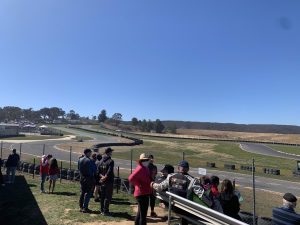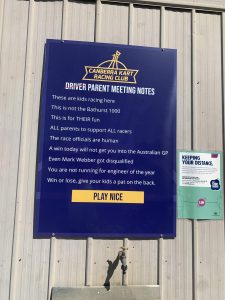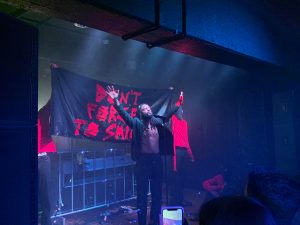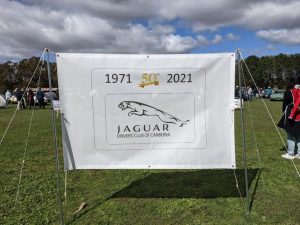Where Stars are Made – A Day at Canberra Kart Racing Club
“And we’re away and racing” were the words that bellowed over the loudspeakers, calling race-goers to hurriedly make their way over to the rickety grand stands to scream, shout and cheer as go-karts zoomed past their faces. This was Sunday at Canberra Kart Racing Club.
To many go-karting is something that you probably did at your twelfth birthday party or with your best friend during the school holidays. It’s some good fun where you can speed around a track and show off to your friends that you’re a quicker driver than them. Out here at the track it’s a little bit different. You’re still driving a go-kart around trying to beat your friends, but you have a commentator, pit crew, fans, sponsors names and brands spattered all over your kart and a really cool looking helmet. Oh, and did I mention that your kart also goes 120 km/h which is a lot quicker than the kart you drove at your birthday which only went a mere 80 km/h.
Motorsport greats such as Lewis Hamilton, Michael Schumacher, Ayrton Senna and Australia’s own Mark Webber started off their careers racing karts. So when I heard a few months ago that Webber himself came back and visited the track in the nations capital that he once called home, I knew that I had to go and learn about this underrated sport for myself.
I’m greeted at the track by the club’s chipper and cheery president Bob Harnas. Even with a facemask hiding his mouth, you can tell that he is smiling. Bob explains to me that the track is very different from usual. With the COVID-19 pandemic in light, all competitors, officials, pit crew and ‘fans’ have to wear some form of surgical mask, to help stop the spread of the virus. Bob handed me one as I hopped out of my car.
For what had been a cold Canberra winter, this Sunday in August was actually quite a warm one. Bob told me that weather such as this usually bought in many spectators, however with the COVID-19 pandemic, this is sadly not allowed.
“We have restricted numbers as you would see. We’re allowed to have 100 entries and 100 spectators. Those spectators are mostly taken up by pit crew, so virtually all we have out here is the driver, the pit crew and the officials.”
Bob continues to walk with me, leading us into the pits. The pits can be best described as a gravel campsite, with tents all over the place. Under each tent you can find go-karts of all different sizes with people of all different sizes working on them. The air smells of petrol and dust and across the pits all you can hear is the sounds of engines roaring to life.
As we walk, you can’t help but notice that Bob is much loved by the karting community. He smiles and says hello to everybody that he sees and is constantly stopped to have a friendly chat, introducing me to everyone along the way. One of the many groups which we stop to chat with consist of three men; Peter, Brendan and Warren.
Friends of Bob’s, these men look like they range from 40 to 60 years old and are wearing what looks like their race suits, in preparation for a later race. They’re having a chuckle whilst watching the races from the gate that separates them from the track. Peter speaks on behalf of the group. He explains to me that every race is split into a class based on age and weight. “We’re racing in Tag Heavy”, he chuckles. He then goes on to describe how the day will play out, “We have three heats, I think there’s a pre final and a final. So overall five races for the day. We should finish up at around four or four thirty.”
Looking around the pits there seems to be other men around the same age and weight as Peter and his friends, getting ready for what was probably an upcoming race. I ask about how many people would be joining him on the track, Peter beamed excitedly, “22! The numbers have gone up since COVID, normally it’s about anywhere from 8 to 15.”
According to the Kart Club’s website, in March this year a track extension was added onto the now named Circuit Mark Webber. Peter believes that this is why so many more people have been coming to the track, “We’ve been racing for 15 years, all over Australia. Queensland, Victoria and all the regional ones too, but this track is good, one of the best in Australia now.”
Looking over the fence I could see that another race was about to start. Peter and his friends eagerly looked over. I decided to wrap up our chat and let them watch the race. They all wave as I walk off.
Having lost Bob amongst the hustle of the pits, I decide to make my way down to the grandstand to watch some racing for myself. Whilst walking I notice what looks like a father and son sitting in some old fold out chairs with an exercise book in hand. I take a closer look and notice that the pair are drawing the track with a pen, discussing intensely what must be strategies for the race. I let the pair be, deciding not to disturb them and consider going back to them at a later time.
I keep moving forward until I make my way to the grandstand. There are two grandstands at the track, one newer metal one and one rickety old one. There are less people on the old one so I sit there. The grandstands are located in between the canteen and commentators box, whose voice you can hear coming out of the speakers nearby. In between races spectators lift up their masks to chomp on their sandwiches and sip on their coffees. I find Bob again wondering around reminding people to keep their masks on and stay socially distant. He smiles at me as he hurriedly walks on by.

As more people start to gather, I hear the sounds of engines roaring onto the track. It’s time for the next race.
Many different coloured helmets zoom past on the track. Some are green, some are yellow and some can only be described as works of art. The karts all seem to be going quite slow. I overhear someone next to me mention that this must be a warm up lap. On this warm up lap, the karts sway side to side, warming up their tyres like how a runner would warm up their muscles before a big race. These are athletes, just not your typical kind.
Coming up the straight, the karts slow down and get into formation. They slowly creep their way up to the start line and then, zoom. In a blink of an eye, they’re gone!
The crowd sitting with me on the grandstands go wild. Some are screaming, some are chewing their fingernails and some are whispering to the ones next to them whilst pointing at the track. The commentators voice on the speakers gets louder with every turn the karts take of the track.
Amongst the rubble and tar of the track, much like a formula one race, there is advertising sprawled across the track. Most of the businesses seem to be local and a few of the karts out on the track seem to have the same logos displayed on them.
With sponsors, commentators, pit crew and fans, it’s hard for me to believe that this is considered a niche sport. There is even a podium set up for the race winners to stand on at the end of the day. I think back to the father and son I saw drawing in their exercise book and think, could this track really be the home to Australia’s next big racing star? I mean it was where the face of the club, Mark Webber, started his career, so it could very well be where our next star starts theirs.
So I get off my seat in the grandstand and make my way back to the pits to search for this father and son. However, when I wander up to the spot they were before, I notice the pair are gone. Disappointed, I continue to search.
During my search I run into Bob again. He asks who I am looking for. I describe to him who I saw but he seems unsure as to whom I am talking about. Instead he offers to take me to another father and son duo who have travelled to the track all the way from Sydney. I happily accept.
Adrian Estasy stands under a blue tent working on a kart whilst his two sons sit in some fold out chairs with their race suits half off, glugging down bottles of water. Bob grabs Adrian’s attention, chatting for a bit, before introducing me. He then states that he has to quickly run off to help out with the next race. Before I could even blink, I see Bob on the track with a leaf blower, helping the officials make everything clear for the next race. I laugh and look back to Adrian and we decide to have a chat.
Adrian tells me that both his sons are racing in the class of junior light. They have been racing in this class for six months but have overall been racing for roughly a year.
With both boys in the same class, when I ask how it is two have to sons who race against each other, he laughs and exclaims, “It’s an interesting dynamic to maintain but so far so good. They have had no major incidents on the track, so no fireworks yet.”
Having raced one heat already today the boys look a bit tired. Placing second and fourth, Adrian states that he is very proud of his boys, “We’ve never been here before. We have no expectations on our first time here, if we get on the podium we’ll be happy.”
Just before leaving to find Bob before I head home for the day I ask if Adrian himself has raced before. This question causes him to have big cheesy grin from ear to ear as he exclaims, “I raced here 50 years ago myself, on the older track. I might have to get my helmet out and give it a crack myself.”
Laughing Adrian and I bring the conversation to the end and I step away to give them time to rest before the next race. Bob returns to my side and we take a walk down to the canteen. I am keen to learn more about the parent child dynamic when it comes to racing, so I ask about his own experience.
Bob informs me that he became a member of the club 13 years ago when his daughter was only seven and even used to race himself, “I used to race but as she got better and faster I went on to just helping her.”
With Bob’s daughter now an adult, he tells me that she still occasionally comes out and races at the club and that those days are his absolute favourite days because they remind him why he started out here in the first place.
 After we continue to chat for a while Bob and I finally say our goodbyes for the day. I thank him for giving me the opportunity to join him at the track today.
After we continue to chat for a while Bob and I finally say our goodbyes for the day. I thank him for giving me the opportunity to join him at the track today.
Walking back to the car I try and digest how professional this sport really is. I think about the adults, the children, the Mums working in the canteen, the officials, the commentator and the fans who all go behind creating and making this sport what it is. However whilst walking I find a sign that I think perfectly sums up what this kart track stands for. It reads;
“These are kids racing here. This is not the Bathurst 1000. This is for THEIR fun. ALL parents to support ALL racers. The race officials are human. A win today will not get you into the Australian GP. Even Mark Webber got disqualified. You are not running for engineer of the year. Win or lose, give your kids a pat on the back. PLAY NICE.”
A sign near the pits at the race track


Be the first to comment!